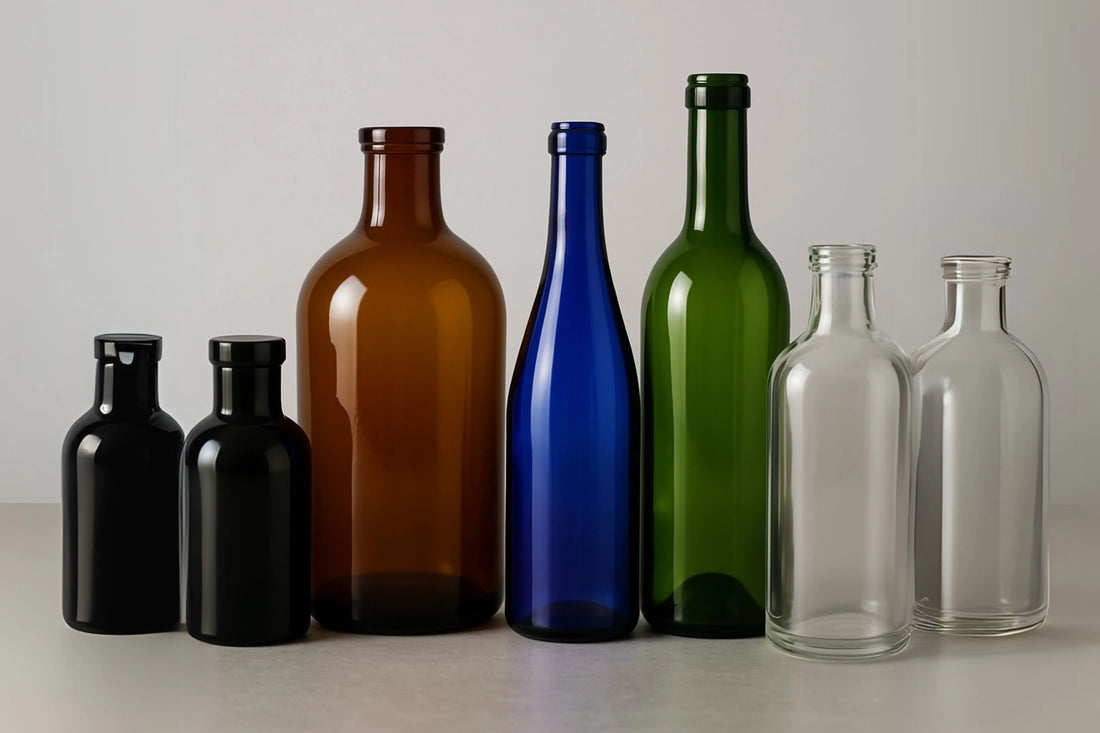Glass bottles come in a variety of colors—but those colors aren't just for show. From amber to cobalt blue, the color of a bottle has a direct impact on how well it protects your product, how it performs on the shelf, and how consumers perceive it.
Let’s walk through the most common glass bottle colors and what makes each one useful, from both a functional and branding perspective.
Why Color Matters in Glass Bottles
The color of a glass bottle plays a huge role in how it interacts with light. Certain wavelengths, like ultraviolet (UV) light, can damage sensitive products like essential oils, gourmet oils, and even some pharmaceuticals. Colored glass containers can reduce exposure to harmful UV light, especially those with darker tones.
Also read: Does Glass Block UV Light
Glass color also impacts marketing. A green glass bottle gives off a different impression than a clear one. Cobalt blue suggests premium quality, while amber glass signals protection and heritage. Choosing the right color isn’t just about science—it’s also about strategy.
Clear Glass (Also Known as Flint Glass)
Best for Showcasing contents like honey, bath salts, or colorful beauty products.
Clear or colorless glass, often called flint bottles, offers zero UV protection. But it’s perfect when the look of your product is a major selling point. These bottles let all light through, including harmful UV wavelengths and blue light.
Use with caution for light-sensitive products, and always store out of direct light.
Amber Glass Bottles: Tried and True Protection>
Best for Essential oils, pharmaceuticals, beer, and herbal tinctures.
Amber-colored glass is the industry standard for products that need protection from UV radiation. Amber blocks most UV light and filters out blue wavelengths, helping to preserve sensitive ingredients and extend shelf life.
Amber glass bottles are a staple in the pharmaceutical and beer industries. They’re typically made with iron, carbon, and sulfur. You’ll also see olive amber bottles used for their slightly greener tint.
Green Glass Bottles: A Natural Look with Moderate Protection
Best for Wine, gourmet oils, spirits, and personal care products.
Green glass is a popular choice in the wine industry, and it’s easy to see why. It offers better UV protection than clear glass but not quite as much as amber. Shades like emerald green, dark green, and antique green each carry unique visual appeal.
Green bottles contain trace elements like chromium and iron in the glass batch, which gives them their characteristic green color. They also work well for brands trying to promote a sustainable or organic image.
Cobalt Blue Glass Bottles: Beauty and Brand Impact
Best for Skincare, aromatherapy sprays, and boutique beauty products.
Cobalt blue bottles aren’t just pretty—they serve a purpose. Made with cobalt oxide, these colored bottles offer moderate protection against UV light. They’re especially popular in the beauty industry where both aesthetic and function matter.
The blue color adds a calming and luxurious touch to a product, making it a smart choice for high-end brands. Cobalt blue bottles have been in use since the 19th century for apothecary and cosmetic products.
Black Glass: Total Light Protection
Best for Premium serums, light-sensitive formulations, high-end apothecary products.
Black glass bottles block out all forms of light—including UV, visible light, and even artificial light. This makes them ideal for products that break down easily under light exposure.
Used frequently in premium and pharmaceutical packaging, black glass ensures your product stays potent and stable. It’s often found in UV glass bottles that offer full-spectrum protection.
Frosted, Aqua-Tinted & Other Color Options
Frosted Glass: Made by etching or sandblasting clear glass. Looks premium but offers no extra light protection unless the base glass does.
Aqua Glass: A pale blue-green tint often found in vintage or antique bottles. Aesthetic more than protective.
White Glass: Rare but used in high-contrast branding where color is controlled by the product label.
Colored Glass Containers in General: Each color offers different levels of light absorption. Lighter bottles provide less protection, while darker bottles absorb more harmful UV light.
Matching Glass Colors to Product Needs
Here’s a quick guide to choosing the right bottle color:
| Glass Color | UV Protection | Best For |
|---|---|---|
| Amber Glass | Excellent | Essential oils, beer, pharma |
| Green Glass | Moderate | Wine, oils, personal care |
| Blue Glass | Moderate | Skincare, wellness products |
| Black Glass | Maximum | Serums, pharmaceuticals |
| Clear Glass | None | Visual products (stored away from light) |
| Frosted Glass | Depends on base glass | Cosmetics, lifestyle branding |
Final Thoughts
The color of your glass bottle can make or break your product—literally. Choosing the right bottle color is more than just a visual decision, whether preserving citrus aromas in gourmet oils or creating a cohesive brand identity.
Colored glass bottles like amber, green, and cobalt blue aren’t just functional; they shape consumer perception. The ability of ultraviolet glass to protect sensitive contents means fewer returns and longer-lasting products.
Whether you're targeting premium brands, apothecary products, or the beer industry, your glass color choice has technical and marketing implications. So the next time you're picking packaging, think beyond the look—think about what your product really needs.




